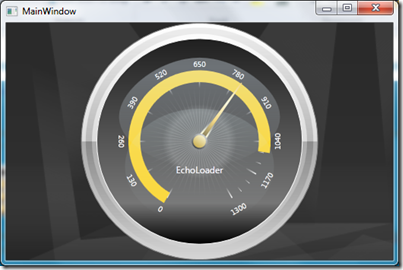Took a little time out tonight from the web application I’m working on as I want to create a little dashboard prototype that has to be desktop based as a result of where it will be used.
I’ve got a server JBPM (Java business process management.. pretty similar to WF4) component that is writing log files, these log files are divided into subdirectories for each JBPM workflow that gets executed.

The idea is to provide a quick view for the counts of server logs at a glance with a gauge, (i'll be putting this gauge into a template for use in a listbox, but as a first step I’ve just displayed the details of the files in the first workflow folder.
Here’s what it looks like

The text is bound to the directory name, the yellow/orange radial bar is the count of all the log files in all subdirectories, and the needle is the count of files in the EchoLoader directory.
Here’s the xaml
1: <Window x:Class="Datagenic__Monitor.MainWindow"
2: xmlns="http://schemas.microsoft.com/winfx/2006/xaml/presentation"
3: xmlns:x="http://schemas.microsoft.com/winfx/2006/xaml"
4: xmlns:telerik="http://schemas.telerik.com/2008/xaml/presentation"
5: Title="MainWindow" Height="350" Width="525">
6: <Window.Background>
7: <ImageBrush ImageSource="/Datagenic-%20Monitor;component/Images/background.png" />
8: </Window.Background>
9: <Grid>
10: <telerik:RadialGauge>
11: <telerik:RadialScale x:Name="radialScale" Min="0" Max="{Binding Path=MaxScale}" MajorTicks="10"
12: MiddleTicks="1" MinorTicks="3">
13:
14: <telerik:RadialScale.MajorTick>
15: <telerik:MajorTickProperties />
16: </telerik:RadialScale.MajorTick>
17: <telerik:RadialScale.MiddleTick>
18: <telerik:MiddleTickProperties Length="0.07" />
19: </telerik:RadialScale.MiddleTick>
20: <telerik:RadialScale.MinorTick>
21: <telerik:MinorTickProperties Length="0.05" />
22: </telerik:RadialScale.MinorTick>
23:
24: <telerik:RadialScale.Label>
25: <telerik:LabelProperties FontSize="10" />
26: </telerik:RadialScale.Label>
27:
28: <telerik:IndicatorList>
29: <telerik:RadialBar x:Name="gauge1_radialBar" IsAnimated="True"
Value="{Binding Path=TotalLogCount}" />
30:
31: <telerik:Needle x:Name="gauge1_needle" IsAnimated="true"
Value="{Binding Path=WFExecutions[0].LogCount}" />
32: </telerik:IndicatorList>
33: </telerik:RadialScale>
34: </telerik:RadialGauge>
35: <Grid>
36: <Grid.RowDefinitions>
37: <RowDefinition Height="0.60*" />
38: <RowDefinition Height="0.40*" />
39: </Grid.RowDefinitions>
40:
41: <TextBlock Grid.Row="1" VerticalAlignment="Top" HorizontalAlignment="Center"
42: Foreground="GhostWhite" FontFamily="CourierNew"
Text="{Binding Path=WFExecutions[0].FolderName}" />
43: </Grid>
44:
45: </Grid>
46: </Window>
Here’s the code
1: using System;
2: using System.Collections.Generic;
3: using System.Linq;
4: using System.Text;
5: using System.Windows;
6: using System.Windows.Controls;
7: using System.Windows.Data;
8: using System.Windows.Documents;
9: using System.Windows.Input;
10: using System.Windows.Media;
11: using System.Windows.Media.Imaging;
12: using System.Windows.Navigation;
13: using System.Windows.Shapes;
14: using System.Collections.ObjectModel;
15: using System.ComponentModel;
16: using System.IO;
17:
18: namespace Datagenic__Monitor
19: {
20: /// <summary>
21: /// Interaction logic for MainWindow.xaml
22: /// </summary>
23: public partial class MainWindow : Window
24: {
25: public MainWindow()
26: {
27: InitializeComponent();
28:
29: this.DataContext = _wfExecutions;
30: }
31:
32: private WorkflowsExecutions _wfExecutions = new WorkflowsExecutions();
33: }
34:
35:
36: class WorkflowsExecutions :NotifyPropertyChangedBase
37: {
38: public WorkflowsExecutions()
39: {
40: this.WFExecutions = new List<WorkflowExecutions>();
41:
42: // Get the individual folders that corresponds to the logs
43: var executionFolders = System.IO.Directory.EnumerateDirectories(_executionFolder);
44: if (executionFolders != null)
45: executionFolders.ToList().ForEach(f =>
46: {
47: var we = new WorkflowExecutions(f);
48: we.PropertyChanged += ItemPropChanged;
49: this.WFExecutions.Add(we);
50: });
51: }
52:
53: void ItemPropChanged(object sender, PropertyChangedEventArgs e)
54: {
55: if (e.PropertyName == "LogCount")
56: {
57: FirePropertyChanged("TotalLogCount");
58: if (TotalLogCount > MaxScale)
59: FirePropertyChanged("MaxScale");
60: }
61: }
62:
63: public int TotalLogCount
64: {
65: get
66: {
67: return this.WFExecutions.Sum(we => we.LogCount);
68: }
69: set { }
70: }
71:
72: public int MaxScale
73: {
74: get
75: {
76: int max = (int)(this.TotalLogCount * 1.5);
77: max = max + (10 - max % 10);
78: return Math.Max(100, max);
79: }
80: set { }
81: }
82:
83: public List<WorkflowExecutions> WFExecutions { get; set; }
84:
85:
86: private string _executionFolder = Properties.Settings.Default.ExecutionLogFolder;
87:
88:
89:
90: //event PropertyChangedEventHandler PropertyChanged = (s, e) => { };
91: }
92:
93: class WorkflowExecutions : NotifyPropertyChangedBase
94: {
95: public WorkflowExecutions(string folder)
96: {
97: this.FolderName = System.IO.Path.GetFileName(folder);
98: _watcher = new FileSystemWatcher(folder);
99: _watcher.Deleted += (s, e) => Update();
100: _watcher.Created += (s, e) => Update();
101: _watcher.EnableRaisingEvents = true;
102: Update();
103: }
104:
105:
106: public string FolderName { get; set; }
107:
108:
109: public int LogCount
110: {
111: get { return _logCount; }
112: set
113: {
114: _logCount = value;
115: base.FirePropertyChanged("LogCount");
116: }
117: }
118:
119: private void Update()
120: {
121: var files = System.IO.Directory.EnumerateFiles(_watcher.Path);
122: this.LogCount = files.Count();
123: }
124:
125: private int _logCount = 0;
126: private FileSystemWatcher _watcher;
127:
128: }
129: }
The interesting part is the auto scaling, if the TotalLogFile count passes the max scale level the view will get the property changed notification and update it bindings. (Note: I half expect telerik gauge to auto scale, if i spend a few minutes to figure out how…  )
)